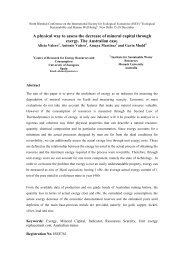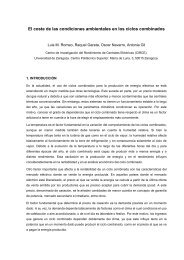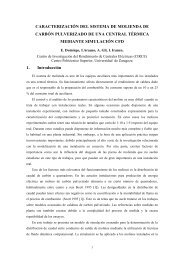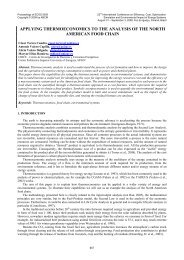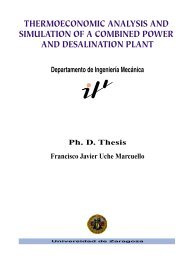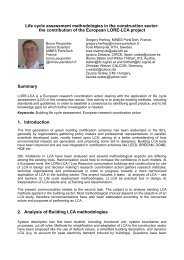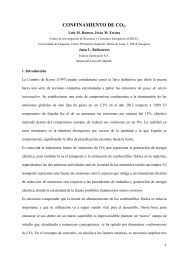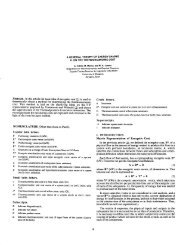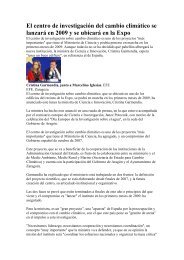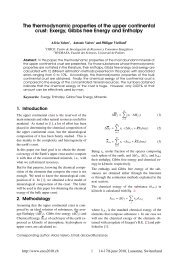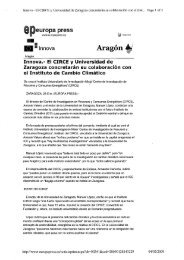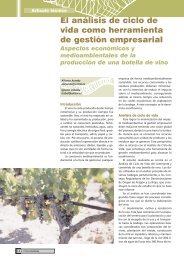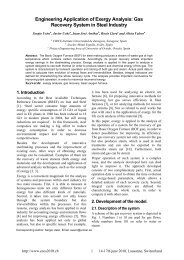CHARACTERIZATION OF A BIOMASS MILLING PILOT ... - circe
CHARACTERIZATION OF A BIOMASS MILLING PILOT ... - circe
CHARACTERIZATION OF A BIOMASS MILLING PILOT ... - circe
Create successful ePaper yourself
Turn your PDF publications into a flip-book with our unique Google optimized e-Paper software.
4.4 Characterization of sampling point<br />
The extracted sample at IS.1 from mills is a<br />
representative of full range of milled biomass particles,<br />
however, this localization presents several problems to<br />
achieve the isokinetic conditions and the sampling can<br />
not be representative of this particle flow.<br />
The obtained samples in GS.1 and IS.2 are not<br />
representative of full range of milled particles. At GS.1<br />
point, it is sampling the collected particles by cyclone. At<br />
IS.2, the particles flow is from not collected in cyclone,<br />
in other words, the very fines particles of the full milled<br />
biomass particles. Both samples are not representative of<br />
full range, but the feasibility of a right sampling is higher<br />
due to, in the first place, GS.1 is a correct system to<br />
obtain a sample in discharge, and in the second place, at<br />
IS.2 presents less problems to achieve the isokinetic<br />
conditions.<br />
The possibility of three sampling point allows:<br />
To obtain a representative sample of the whole<br />
amount of milled biomass using two different<br />
methods.<br />
In the first place, to obtain a representative<br />
sampling of full range at IS.1<br />
In second place, to estimate a representative<br />
sampling of full range as composition of the<br />
obtained sample at GS.1 and IS.2:<br />
χt<br />
=<br />
m<br />
m<br />
m = m + m<br />
t<br />
GS1<br />
IS 2<br />
m<br />
· χ IS<br />
GS1<br />
IS 2<br />
χGS1<br />
+ ·<br />
GS1<br />
+ mIS<br />
2 mGS1<br />
+ mIS<br />
2<br />
where:<br />
χ: analyzed property (granulometry, moisture<br />
content, chemical composition or shape factor).<br />
Note: bulk density can not calculate as<br />
composition of both samples.<br />
m GS1: mass flux solids at GS.1<br />
mIS2: mass flux solids at IS.2<br />
Validation of extracted sample at IS.1 through<br />
the comparison his properties with the<br />
properties of the composed sample from GS.1<br />
and IS.2<br />
4.3.2 Milled biomass sample analysis<br />
Milled biomass characterization involves:<br />
Particle size distribution:<br />
It represents the mass percentage for each<br />
particle size interval. It is the most important<br />
parameter in analysis of milled product.<br />
Shape factor.<br />
The spherical approximation is a used<br />
<br />
commonly in powder handling. However, the<br />
milled biomass presents usually a cylindrical<br />
shape. Shape factor allows to asses the final<br />
particle shape.<br />
Moisture content<br />
This parameter is expressed as:<br />
Ww<br />
−Wd<br />
M = 100<br />
Ww<br />
where M is the moisture content expressed in<br />
percentage of wet matter, Ww is the weight of<br />
the wet sample and Wd the weight of the dry<br />
sample.<br />
The difference between inlet and outlet<br />
moisture content allows to asses the drying<br />
2<br />
effect during comminution. Several studies [8-<br />
10] have observed a decrease between 10 and<br />
30% of the initial moisture content as function<br />
different factors.<br />
Bulk density.<br />
Miling is ones of solids densification process<br />
due to bulk density increase with particle size<br />
decrease.<br />
Chemical composition<br />
It is observable that the particle size shows<br />
influence on chemical properties [21].<br />
5 CONCLUSIONS<br />
Several parameters have been instrumented to assess<br />
the influence on particle residence time on grinding<br />
chamber and on drying effect:<br />
Pressure, temperature, humidity and mass flow<br />
air at mill inlet and outlet.<br />
Moisture content, temperature and feed rate of<br />
biomass at mills inlet and outlet.<br />
Variable speed drives have been installed in<br />
mills to control the energy impact, in fans to<br />
control the mill outlet pressure and in belt<br />
conveyor to control the biomass feed rate.<br />
Milled biomass properties characterization has been<br />
realized to analyse the parameters influence on the final<br />
product properties.<br />
Three sampling methods have been studied to obtain<br />
a representative sample of milling process:<br />
Coning and quartering sampling can show size<br />
segregration due to the sample is taken out<br />
form stored milled biomass.<br />
Two-way distributor has been installed to<br />
obtain a representative sample in gravity<br />
discharge. Particle flow is in motion and size<br />
segregation is avoided.<br />
Two isokinetic sampling points have been<br />
analyzed where the air-particle flow conditions<br />
are extremely different. At first point, high<br />
solids concentration of all range of milled<br />
particle sizes in horizontal ducts, isokinetic<br />
sampling presents inertial effect of coarse<br />
particle, possible asymmetry in the solids<br />
concentration profiles as function sampling<br />
point height from the bottom of the pipe in the<br />
vertical plane of the cross section and finally,<br />
erroneous solid concentration measurement in<br />
case of anisokinetic sampling.<br />
At second point, low air-particles concentration<br />
of fines particles, isokinetic sampling can<br />
realize suitable, even the concentration<br />
measurement and representative sample can be<br />
obtained in anisokinetic conditions.<br />
Possibility to obtain two representative<br />
sampling of full range of milled biomass size:<br />
isokinetic sampling at first point and as<br />
composition of isokinetic sample at second<br />
point (fines particles representative) and gravity<br />
discharge sample (coarse particles<br />
representative).<br />
First isokinetic sample validation in<br />
comparison with a composition sample of<br />
gravity discharge sample and second isokinetic<br />
sample.



